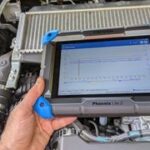Otitis media (OM) is a common childhood ailment, placing a significant burden on public health resources. The indirect costs associated with OM, such as missed school or work days for medical consultations, are substantial. Developing an effective homecare solution for OM is therefore highly desirable. This study explores the potential of an Automatic Diagnostic algorithm for pediatric OM using artificial intelligence and image processing.
This diagnostic system utilizes otoscopic images for analysis. From a collection of 1,230 images, 214 diagnosed cases of acute otitis media (AOM) and otitis media with effusion (OME) formed the core database for image classification. The system randomly divides this database into training and testing subsets. For each image in both sets, the eardrum region is segmented, followed by the extraction of key image features, including color and shape. A multitask joint sparse representation-based classification method, combining these various image features, then categorizes the OM images.
The algorithm’s performance in differentiating between AOM and OME images is promising. Results indicate a high classification accuracy of 91.41%. This suggests that the multitask joint sparse representation algorithm effectively analyzes the extracted image features to accurately distinguish between these two common forms of OM.
This automated diagnostic approach offers significant potential for improving OM management in children. The high accuracy rate suggests its viability as a tool for early detection and ongoing home monitoring. By enabling parents to assess their child’s ear health, the algorithm could minimize disease consequences and reduce the need for frequent clinic visits. This cost-effective solution may also contribute to better public health outcomes by facilitating timely intervention and reducing the overall burden of pediatric OM.
The algorithm’s ability to accurately classify AOM and OME images demonstrates the potential of automatic diagnostic tools in pediatric healthcare. Further research and development could refine this technology, potentially leading to widespread implementation in home and clinical settings. This automated approach promises to improve access to care, reduce healthcare costs, and enhance the overall management of pediatric otitis media.
